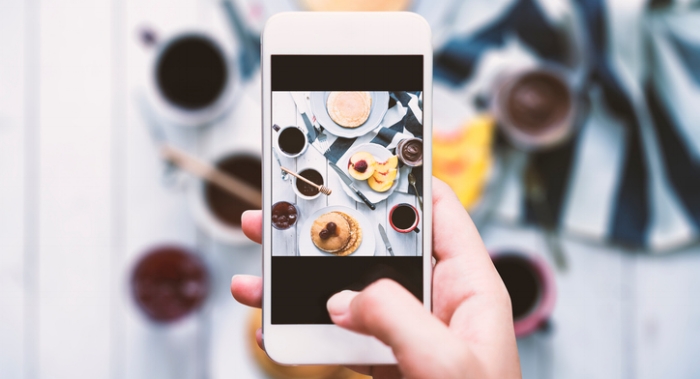What I Know About the Instagram Algorithm

People talk about algorithms a lot these days.
I think it's safe to say that most of us don't really know exactly what an algorithm is. We assume it's some kind of complicated formula created by a Silicon Valley tech nerd that determines what we see in our social media feeds. Is this right? I heard someone refer to it as the algo recently, which is fun shorthand I may start using.
As you know, lots of peeps are pretty huffy about Instagram's algorithm. Perhaps this is because they work in marketing and were relying on a chronological feed (which is so 2015) or perhaps they just don't know how it works and what to strive for in order to perform well under the current rules.
The thing is, the algorithm is actually designed to cater to what people want to see. I hate to break it to you, but it's true. It's not working against you; it's working for what people want to see the most. If you like a bunch of a certain person's photos or go directly to their profile on a regular basis to see their dope ass grid, it will show you more of their photos and put them at the top of your feed. That makes a lot of sense, right? So don't be mad.
Of course, this doesn't sit well with some content creators, because they want more pull on people seeing their posts. And yes, it caters more to the observer than the creator, but this can be worked with. It sounds cheesy, but if you go about things the honest way and post good, consistent content, people will respond positively to that. After all, content is queen.
Now before we begin with all this IG algo knowledge, it should be noted that Instagram doesn't publicly say what goes into their algorithm or when they make changes and updates. People sort of just figure it out when they switch things up and sometimes share this information on the Internet. (The same goes for Google—the index ranking rules are actually just hearsay, which is pretty fascinating to me.)
Okay, enough of this nerdy mumbo jumbo. Here are some things I've found out about the Instagram algorithm:
1.
Engagement is a keyword that matters with Instagram and it refers to the amount of likes, comments, shares, and saves your posts get. Engagement rate is your average engagement divided by the number of followers you have. So if you get an average of 100 likes and comments on each of your posts and you have 1,000 followers, your engagement rate would be 10% (which is high). Platforms like PeopleMap will calculate this for you.
2.
If your posts have high engagement within the first hour they're uploaded, they will stay in the feed for days. You know how sometimes you scroll through the feed and someone's post from like 4 days ago pops up? This is why. If your post doesn't perform well right off the bat, it will get buried. For this reason, a lot of social media influencers reply immediately to comments on their posts, because this increases their engagement within the first hour.
3.
Instagram wants to you use their product so they reward people who spend a lot of time on it. This means posting often, scrolling through your feed, and liking and commenting on other people's posts. Don't be a passive user. So like, if you're one of those snobs that follows 0 people on Instagram, this may hurt you. Unless you're literally Beyoncé because she follows 0 people and is still somehow God.
4.
Hashtags have a bad rap, but they're also a really useful tool. They essentially provide a way for you to "google" things within the app and they allow people who don't already follow you to find your posts and discover your account. Instagram allows you to use up to 30 hashtags per post. You can include these in your caption or you can paste them into a comment. I heard that putting hashtags in a comment makes it so your photos don't show up in searches, but then I read that this was just a glitch, and it appears it has since been corrected. There's an app called Focalmark that generates relevant hashtags for any topic or location you enter. Just don't stuff your posts with irrelevant hashtags. Instagram may flag you for this.
5.
Instagram is not a fan of cheaters. This means they don't like when people use robots or automation to comment and like posts, they don't like automated posting platforms like Buffer, and they don't like comment pods. Previously, there may have been ways to use these shortcuts without them noticing, but they're getting smarter and smarter and their algorithm updates always make these things harder to do without getting flagged. They want real people to post real photos and run their own accounts. Again, posting consistent, authentic content that people like is the best way to succeed on the app. They also don't like spammy behavior, so don't follow and unfollow 200 accounts in a row.
6.
If you edit your caption or tag more accounts in a photo after posting it, your post will no longer show up in hashtag searches. I think this is because if someone likes your photo and you change the caption to say something really messed up that they don't agree with, it's almost as if you stole their like. I mean, this probably never happens, but the point is to never edit anything after you post it. I always pre-write my caption in the notes app on my phone, reread it a few times to make sure there aren't any typos, and then paste it into the app.
7.
If you get a business account, you can see when your followers use the app the most on average each day and post at that time. In order to get a biz account, you have to have a business page on Facebook first and then link the two. Instagram's business account feature is free and provides lots of other insights like how many profile visits or new followers your post led to. Additionally, it shows you how many people saved your post and how many users viewed the photo through a hashtag search. (You can also follow hashtags now, which is pretty cool.)
8.
If you post more than once per day, people may not see both of your posts in their feed. Remember how I said a post's ranking in the feed depends on how well it does in the first hour? Well, if someone opens the Instagram app only once per day—seems wild, but some people have the self-control—then they may only see your post that performed well while the other one gets buried in their feed. Posting once per day is great, but if you post some real quality shit once a week or every few days, that's wonderful too. Also, videos are the future and Generation Z (the folks younger than Millennials) want everything to be a video. So if you want your brand to succeed in the next decade, get with it.
9.
Again, the Instagram gods want you to use their product and their newest features. This means you'll be favored if you post Instagram Stories, highlight your stories, use the discover feature, and follow some hashtags. Plus, Insta Stories are free real estate, so if you really want your content to be seen, utilize this feature.
Here are some additional Instagram thoughts and tips that have nothing to do with the algorithm.
These tips can be used as much you want, depending on how much you care, which might not be much at all.
1.
Plan out your grid with an app like Unum or Planoly. Why? Because when someone checks out your Instagram profile, they'll decide whether or not to follow you based on the first 9 photos of your grid. If the colors are all wack and it's not uniform, they may pass. And I mean, fuck 'em, but also if you're trying to grow a brand, you'll want your grid to look pretty. These apps allow you to plan out your grid ahead of time to see how it will look. For example, if there's too much of a certain color in one row, you may choose to save that photo for another time.
2.
Use the same filter on all your photos. This goes hand in hand with tip #1 as it will make your profile look much more professional. I use VSCO (specifically the HB2 filter because I like how it saturates black) and Darkroom.
3.
Post what you want to post! People talk shit about food photos on Instagram but the reality is that there's totally an audience for it. Food bloggers—especially health food bloggers and vegan bakers—have some of the hugest Instagram followings! People do like that stuff, whether it's frowned upon by others or not. The beauty of the Internet is that if you have a weird niche or create content about something that most people aren't into, there's still going to be a couple million people in the world (at least) who like it and relate to it. This is also why the Internet has done wonders for fetishes.
4.
Flat lays look fake, but people love them! Curated items on a white surface look curated of course, but I think that's sort of the point. Art snobs be like, "That's not art!!" And yeah, maybe it's not, but it is creative expression, so let people be.


